Comprehensive Analysis of Inflation and Unemployment in Australia
VerifiedAdded on 2021/05/31
|7
|1299
|59
Report
AI Summary
This report provides an analysis of inflation and unemployment in Australia, examining their relationship and the impact of various economic factors. It explores the consumer price index, unemployment rates, and the effects of tariffs, government expenditure, and migration on the real GDP and economic growth. The report highlights the negative correlation between unemployment and inflation, discusses the influence of exports and imports, and analyzes the government's role in managing the economy through fiscal policies. It also considers the impact of migration on the labor force and overall prices, concluding with recommendations for government action to address unemployment and stimulate economic growth. The report references data from the Australian Bureau of Statistics and other sources to support its findings.
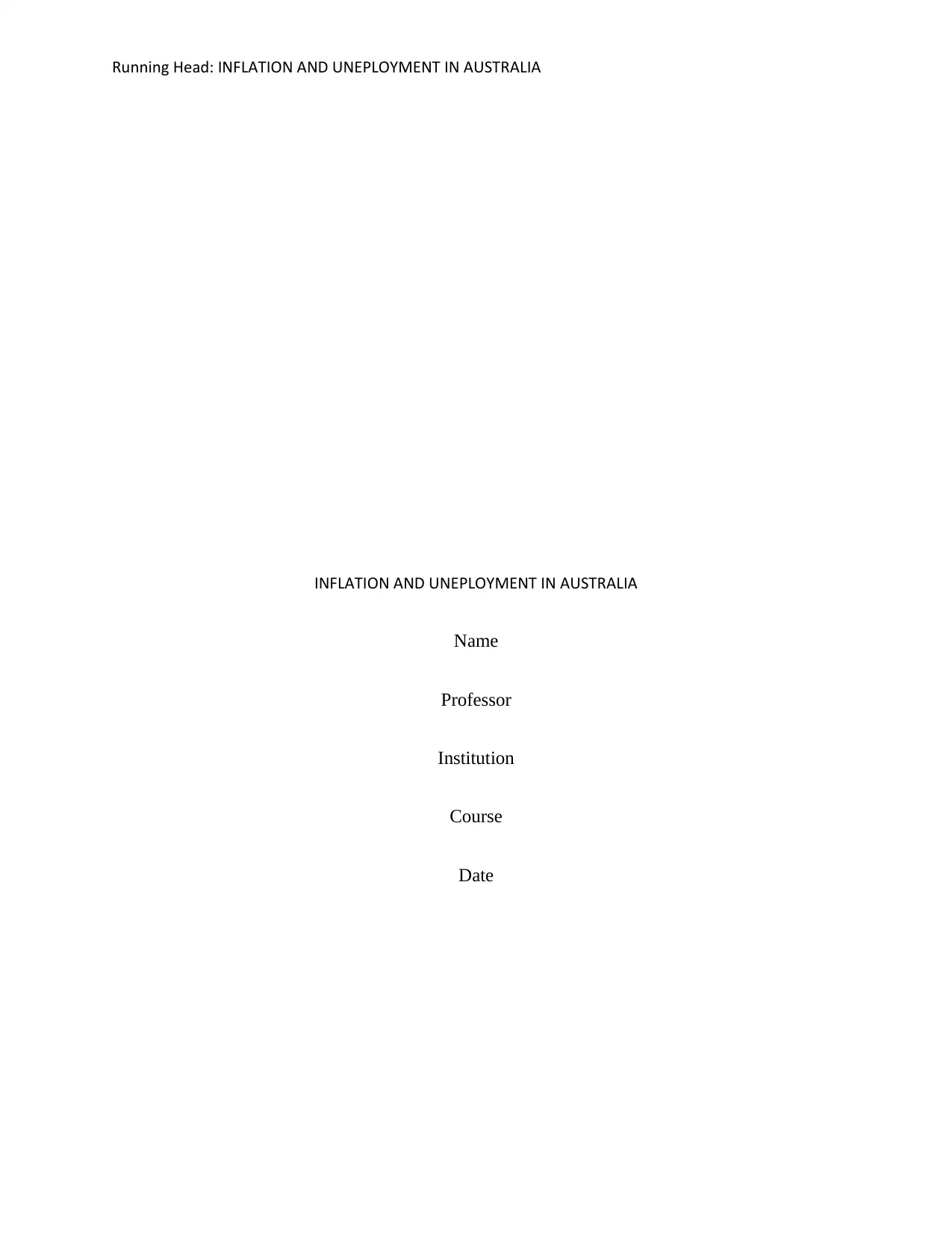
Running Head: INFLATION AND UNEPLOYMENT IN AUSTRALIA
INFLATION AND UNEPLOYMENT IN AUSTRALIA
Name
Professor
Institution
Course
Date
INFLATION AND UNEPLOYMENT IN AUSTRALIA
Name
Professor
Institution
Course
Date
Paraphrase This Document
Need a fresh take? Get an instant paraphrase of this document with our AI Paraphraser
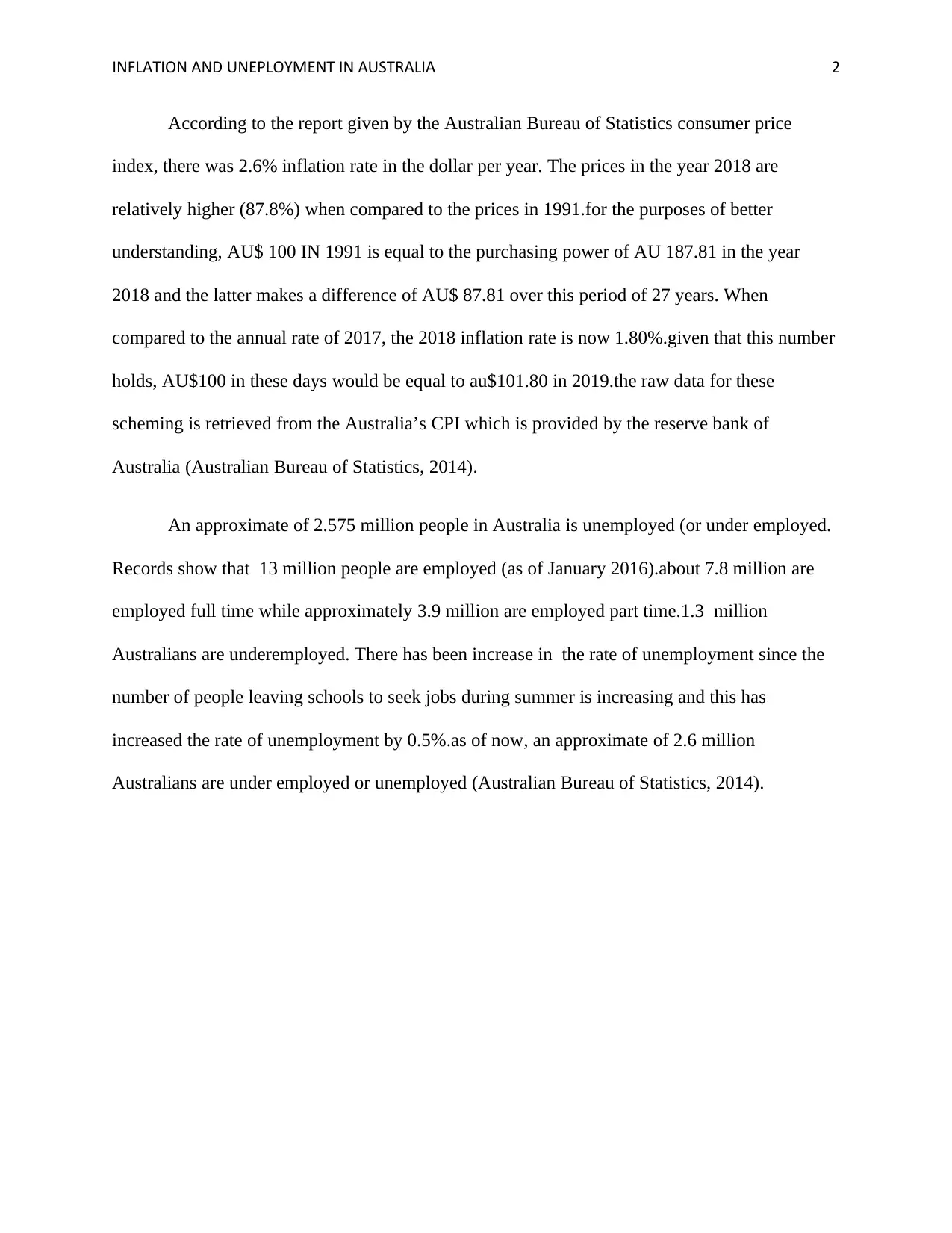
INFLATION AND UNEPLOYMENT IN AUSTRALIA 2
According to the report given by the Australian Bureau of Statistics consumer price
index, there was 2.6% inflation rate in the dollar per year. The prices in the year 2018 are
relatively higher (87.8%) when compared to the prices in 1991.for the purposes of better
understanding, AU$ 100 IN 1991 is equal to the purchasing power of AU 187.81 in the year
2018 and the latter makes a difference of AU$ 87.81 over this period of 27 years. When
compared to the annual rate of 2017, the 2018 inflation rate is now 1.80%.given that this number
holds, AU$100 in these days would be equal to au$101.80 in 2019.the raw data for these
scheming is retrieved from the Australia’s CPI which is provided by the reserve bank of
Australia (Australian Bureau of Statistics, 2014).
An approximate of 2.575 million people in Australia is unemployed (or under employed.
Records show that 13 million people are employed (as of January 2016).about 7.8 million are
employed full time while approximately 3.9 million are employed part time.1.3 million
Australians are underemployed. There has been increase in the rate of unemployment since the
number of people leaving schools to seek jobs during summer is increasing and this has
increased the rate of unemployment by 0.5%.as of now, an approximate of 2.6 million
Australians are under employed or unemployed (Australian Bureau of Statistics, 2014).
According to the report given by the Australian Bureau of Statistics consumer price
index, there was 2.6% inflation rate in the dollar per year. The prices in the year 2018 are
relatively higher (87.8%) when compared to the prices in 1991.for the purposes of better
understanding, AU$ 100 IN 1991 is equal to the purchasing power of AU 187.81 in the year
2018 and the latter makes a difference of AU$ 87.81 over this period of 27 years. When
compared to the annual rate of 2017, the 2018 inflation rate is now 1.80%.given that this number
holds, AU$100 in these days would be equal to au$101.80 in 2019.the raw data for these
scheming is retrieved from the Australia’s CPI which is provided by the reserve bank of
Australia (Australian Bureau of Statistics, 2014).
An approximate of 2.575 million people in Australia is unemployed (or under employed.
Records show that 13 million people are employed (as of January 2016).about 7.8 million are
employed full time while approximately 3.9 million are employed part time.1.3 million
Australians are underemployed. There has been increase in the rate of unemployment since the
number of people leaving schools to seek jobs during summer is increasing and this has
increased the rate of unemployment by 0.5%.as of now, an approximate of 2.6 million
Australians are under employed or unemployed (Australian Bureau of Statistics, 2014).
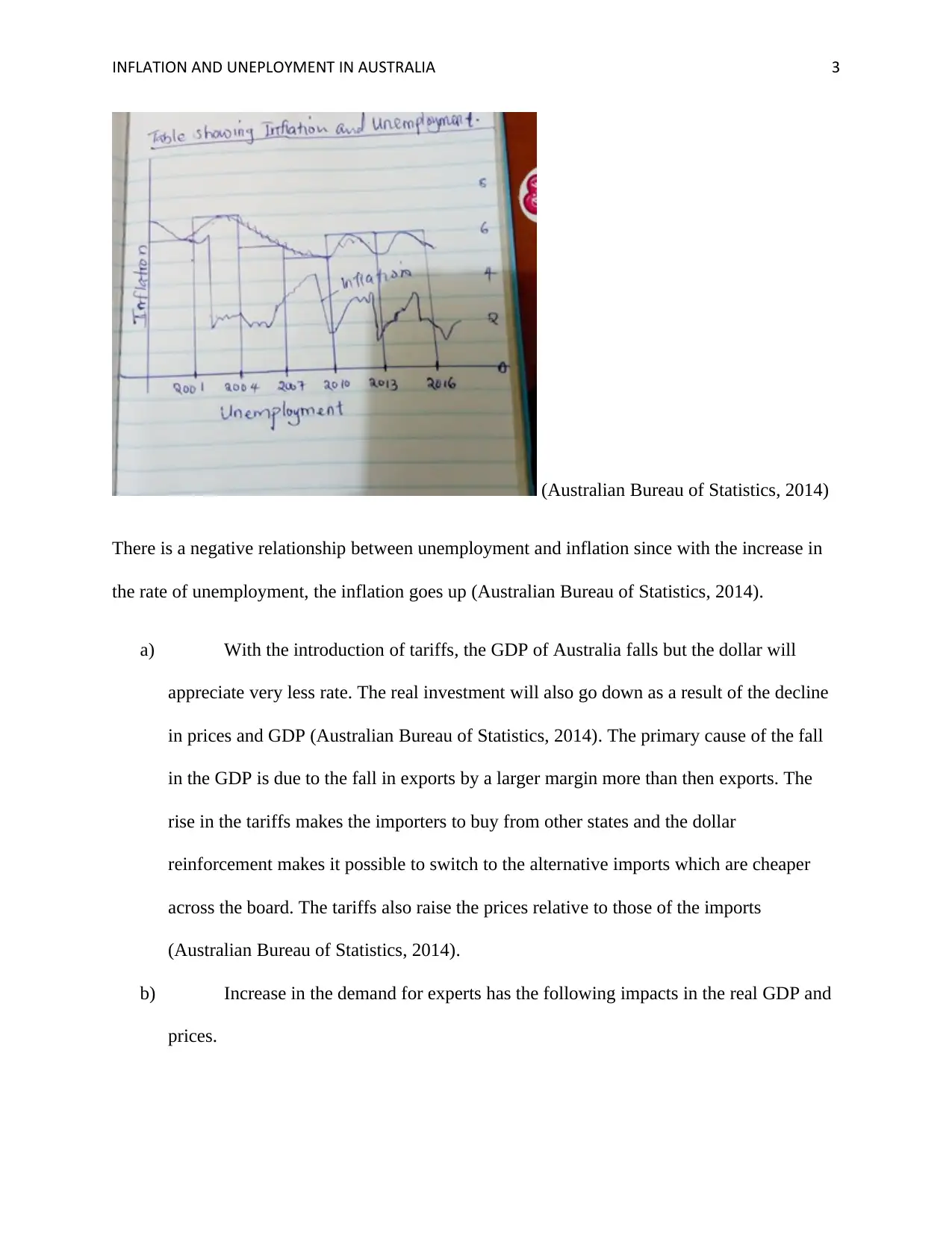
INFLATION AND UNEPLOYMENT IN AUSTRALIA 3
(Australian Bureau of Statistics, 2014)
There is a negative relationship between unemployment and inflation since with the increase in
the rate of unemployment, the inflation goes up (Australian Bureau of Statistics, 2014).
a) With the introduction of tariffs, the GDP of Australia falls but the dollar will
appreciate very less rate. The real investment will also go down as a result of the decline
in prices and GDP (Australian Bureau of Statistics, 2014). The primary cause of the fall
in the GDP is due to the fall in exports by a larger margin more than then exports. The
rise in the tariffs makes the importers to buy from other states and the dollar
reinforcement makes it possible to switch to the alternative imports which are cheaper
across the board. The tariffs also raise the prices relative to those of the imports
(Australian Bureau of Statistics, 2014).
b) Increase in the demand for experts has the following impacts in the real GDP and
prices.
(Australian Bureau of Statistics, 2014)
There is a negative relationship between unemployment and inflation since with the increase in
the rate of unemployment, the inflation goes up (Australian Bureau of Statistics, 2014).
a) With the introduction of tariffs, the GDP of Australia falls but the dollar will
appreciate very less rate. The real investment will also go down as a result of the decline
in prices and GDP (Australian Bureau of Statistics, 2014). The primary cause of the fall
in the GDP is due to the fall in exports by a larger margin more than then exports. The
rise in the tariffs makes the importers to buy from other states and the dollar
reinforcement makes it possible to switch to the alternative imports which are cheaper
across the board. The tariffs also raise the prices relative to those of the imports
(Australian Bureau of Statistics, 2014).
b) Increase in the demand for experts has the following impacts in the real GDP and
prices.
⊘ This is a preview!⊘
Do you want full access?
Subscribe today to unlock all pages.

Trusted by 1+ million students worldwide
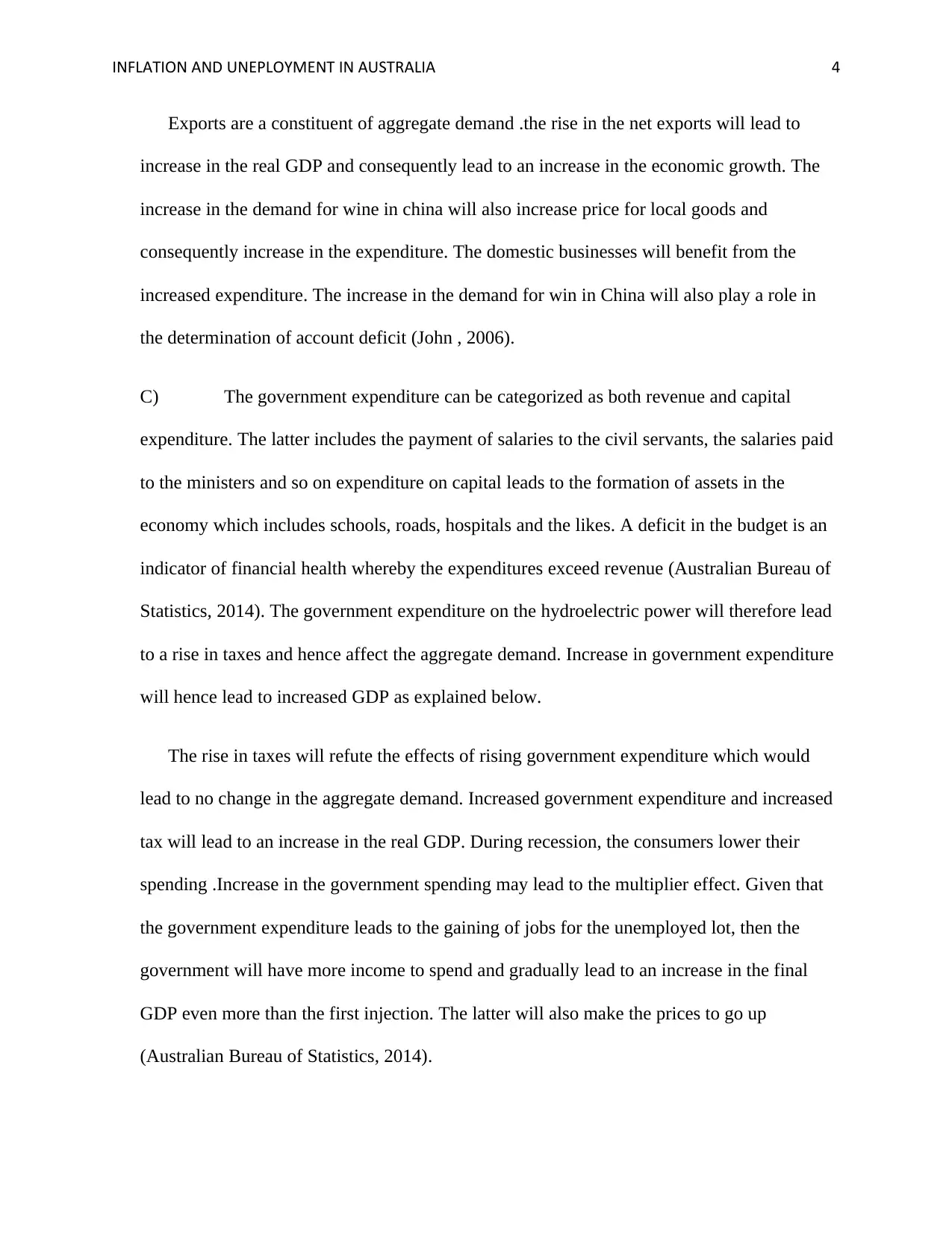
INFLATION AND UNEPLOYMENT IN AUSTRALIA 4
Exports are a constituent of aggregate demand .the rise in the net exports will lead to
increase in the real GDP and consequently lead to an increase in the economic growth. The
increase in the demand for wine in china will also increase price for local goods and
consequently increase in the expenditure. The domestic businesses will benefit from the
increased expenditure. The increase in the demand for win in China will also play a role in
the determination of account deficit (John , 2006).
C) The government expenditure can be categorized as both revenue and capital
expenditure. The latter includes the payment of salaries to the civil servants, the salaries paid
to the ministers and so on expenditure on capital leads to the formation of assets in the
economy which includes schools, roads, hospitals and the likes. A deficit in the budget is an
indicator of financial health whereby the expenditures exceed revenue (Australian Bureau of
Statistics, 2014). The government expenditure on the hydroelectric power will therefore lead
to a rise in taxes and hence affect the aggregate demand. Increase in government expenditure
will hence lead to increased GDP as explained below.
The rise in taxes will refute the effects of rising government expenditure which would
lead to no change in the aggregate demand. Increased government expenditure and increased
tax will lead to an increase in the real GDP. During recession, the consumers lower their
spending .Increase in the government spending may lead to the multiplier effect. Given that
the government expenditure leads to the gaining of jobs for the unemployed lot, then the
government will have more income to spend and gradually lead to an increase in the final
GDP even more than the first injection. The latter will also make the prices to go up
(Australian Bureau of Statistics, 2014).
Exports are a constituent of aggregate demand .the rise in the net exports will lead to
increase in the real GDP and consequently lead to an increase in the economic growth. The
increase in the demand for wine in china will also increase price for local goods and
consequently increase in the expenditure. The domestic businesses will benefit from the
increased expenditure. The increase in the demand for win in China will also play a role in
the determination of account deficit (John , 2006).
C) The government expenditure can be categorized as both revenue and capital
expenditure. The latter includes the payment of salaries to the civil servants, the salaries paid
to the ministers and so on expenditure on capital leads to the formation of assets in the
economy which includes schools, roads, hospitals and the likes. A deficit in the budget is an
indicator of financial health whereby the expenditures exceed revenue (Australian Bureau of
Statistics, 2014). The government expenditure on the hydroelectric power will therefore lead
to a rise in taxes and hence affect the aggregate demand. Increase in government expenditure
will hence lead to increased GDP as explained below.
The rise in taxes will refute the effects of rising government expenditure which would
lead to no change in the aggregate demand. Increased government expenditure and increased
tax will lead to an increase in the real GDP. During recession, the consumers lower their
spending .Increase in the government spending may lead to the multiplier effect. Given that
the government expenditure leads to the gaining of jobs for the unemployed lot, then the
government will have more income to spend and gradually lead to an increase in the final
GDP even more than the first injection. The latter will also make the prices to go up
(Australian Bureau of Statistics, 2014).
Paraphrase This Document
Need a fresh take? Get an instant paraphrase of this document with our AI Paraphraser

INFLATION AND UNEPLOYMENT IN AUSTRALIA 5
If the economy is however at full capacity, an increase in the government expenditure
will lead to the crowding effect whereby the private sector will crowd out leading to little or
even no net increase in the aggregate demand moving from private sector expenditure to
government expenditure (John , 2006).
d) In the calculation of GDP, the net exports and imports should always be balanced,
with the net difference either increasing or decreasing. If the exports are greater than the
imports, then there is an increase in the GDP. The latter is also known as the current
surplus. The growth rate in the GDP is the relative difference or the rate of alteration in
the real GDP from one phase to the other. The current account (the balance of the imports
and exports) can make the GDP go up or down and thus have an impact on its growth
rate. With the fall in the prices of oil in Australia, the GDP will experience a slow rate of
growth (Australian Bureau of Statistics, 2014).
e) Migration in Australia has been of great influence to the economy. The latter
affects the size, and geographic composition of the work force. The recent changes in the
migration program for Australia has a greater emphasis on skills and the increased
number of temporary immigrants. The number of emigrants has been less than the
number of immigrants in the recent past. There is no clear stand on whether the
immigration has direct impact on the real GDP and the general prices. Increase in the
number of immigrants has led to increased labor force (John , 2006). The increase in
labor force will lead to increase in the general prices. The real GDP will also go down
since the level of reliance in the work force will increase with increase in the rate of
unemployment (John , 2006).
RATIONALE
If the economy is however at full capacity, an increase in the government expenditure
will lead to the crowding effect whereby the private sector will crowd out leading to little or
even no net increase in the aggregate demand moving from private sector expenditure to
government expenditure (John , 2006).
d) In the calculation of GDP, the net exports and imports should always be balanced,
with the net difference either increasing or decreasing. If the exports are greater than the
imports, then there is an increase in the GDP. The latter is also known as the current
surplus. The growth rate in the GDP is the relative difference or the rate of alteration in
the real GDP from one phase to the other. The current account (the balance of the imports
and exports) can make the GDP go up or down and thus have an impact on its growth
rate. With the fall in the prices of oil in Australia, the GDP will experience a slow rate of
growth (Australian Bureau of Statistics, 2014).
e) Migration in Australia has been of great influence to the economy. The latter
affects the size, and geographic composition of the work force. The recent changes in the
migration program for Australia has a greater emphasis on skills and the increased
number of temporary immigrants. The number of emigrants has been less than the
number of immigrants in the recent past. There is no clear stand on whether the
immigration has direct impact on the real GDP and the general prices. Increase in the
number of immigrants has led to increased labor force (John , 2006). The increase in
labor force will lead to increase in the general prices. The real GDP will also go down
since the level of reliance in the work force will increase with increase in the rate of
unemployment (John , 2006).
RATIONALE
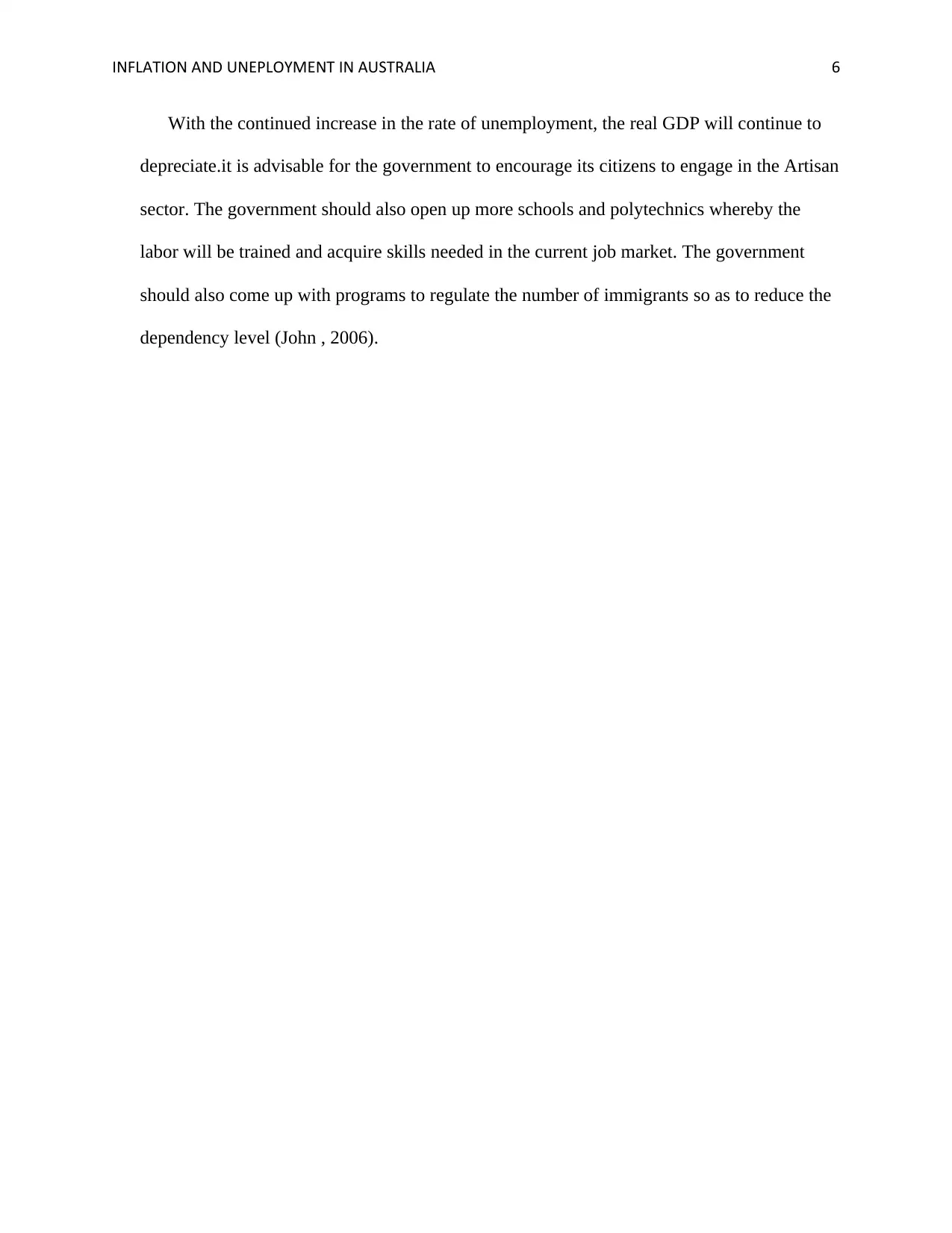
INFLATION AND UNEPLOYMENT IN AUSTRALIA 6
With the continued increase in the rate of unemployment, the real GDP will continue to
depreciate.it is advisable for the government to encourage its citizens to engage in the Artisan
sector. The government should also open up more schools and polytechnics whereby the
labor will be trained and acquire skills needed in the current job market. The government
should also come up with programs to regulate the number of immigrants so as to reduce the
dependency level (John , 2006).
With the continued increase in the rate of unemployment, the real GDP will continue to
depreciate.it is advisable for the government to encourage its citizens to engage in the Artisan
sector. The government should also open up more schools and polytechnics whereby the
labor will be trained and acquire skills needed in the current job market. The government
should also come up with programs to regulate the number of immigrants so as to reduce the
dependency level (John , 2006).
⊘ This is a preview!⊘
Do you want full access?
Subscribe today to unlock all pages.

Trusted by 1+ million students worldwide

INFLATION AND UNEPLOYMENT IN AUSTRALIA 7
REFERENCES
Australian Bureau of Statistics. (2014, June 05). Australian Social Trends. Retrieved may 25th,
2017, from Australian Bureau of Statistics:
http://www.abs.gov.au/AUSSTATS/abs@.nsf/Lookup/4102.0Main+Features202014?
OpenDocument
John , S. (2006, may 17th). Economic Impacts of Migration and Population Growth. Retrieved
May 26th, 2017, from Australian Government Productivity Commission:
https://www.pc.gov.au/inquiries/completed/migration-population/report
REFERENCES
Australian Bureau of Statistics. (2014, June 05). Australian Social Trends. Retrieved may 25th,
2017, from Australian Bureau of Statistics:
http://www.abs.gov.au/AUSSTATS/abs@.nsf/Lookup/4102.0Main+Features202014?
OpenDocument
John , S. (2006, may 17th). Economic Impacts of Migration and Population Growth. Retrieved
May 26th, 2017, from Australian Government Productivity Commission:
https://www.pc.gov.au/inquiries/completed/migration-population/report
1 out of 7
Related Documents
Your All-in-One AI-Powered Toolkit for Academic Success.
+13062052269
info@desklib.com
Available 24*7 on WhatsApp / Email
![[object Object]](/_next/static/media/star-bottom.7253800d.svg)
Unlock your academic potential
Copyright © 2020–2025 A2Z Services. All Rights Reserved. Developed and managed by ZUCOL.





